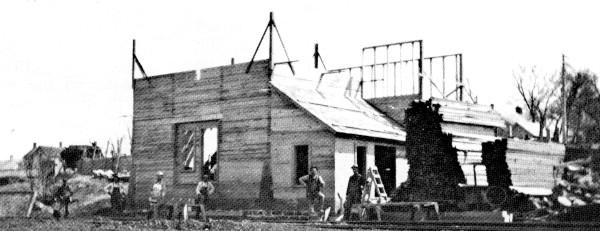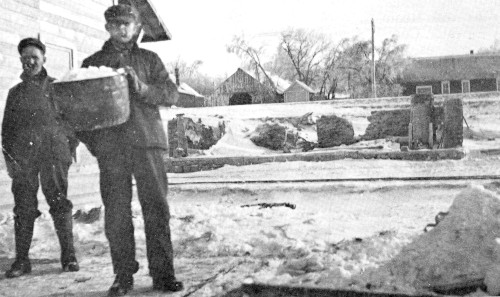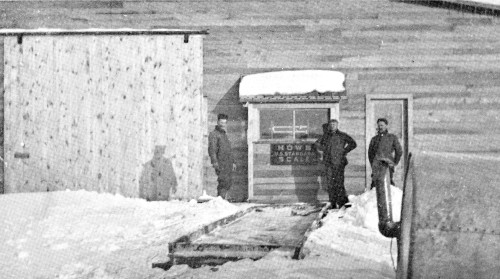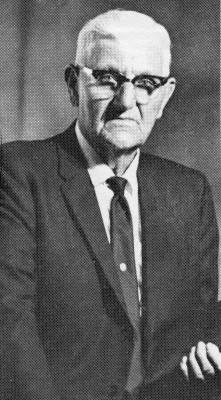

LUMBER YARD/ELEVATOR
Throughout the years, the lumber yard and elevator business went
hand-in-hand, sometimes apparently being managed by the same person, other
times managed separately. But the two businesses were always located close
together, on the north side of the railroad tracks where lumber could easily be
unloaded from trains and the grain stored in the elevators could be shipped
out. Coal was shipped into town here, too.
The rich farm lands around Aspinwall produced an abundance of grain, keeping as many as five grain buyers busy. In 1884, our lists show Packard and Arnold operating one firm and Tom Dutt buying corn, selling lumber and buying cattle. Tom's brother E.R. Dutt was a hog buyer and sold land, and the Dutt Brothers, according to the newspaper, were "two of Aspinwall's best businessmen." There were also two coal dealers in town at that time.
Business was apparently very good. In September, 1884, the Dutt Brothers were adding new scales; by mid-1886, two new dealers had come into town, Van Patton and G.A. Smith, and the Manning Monitor announced in the August 5, 1886 edition, "A bank, another store, and another lumber yard are some of the Aspinwall wants; very good openings for the right men."
When Manilla was founded just three months later, it was announced that Packard had purchased one of the first lots there; others may have followed.
Meves Schacht, who owned and operated one of the first general stores in town, also dealt in grain and lumber. He may have entered the business somewhat by accident; there was a recession in the late 1880s and Schacht said he would accept grain as payment for groceries and other purchases at his store. So many people took him up on the offer that corn cribs were set up all over town to hold the corn. The recession ended, the price of grain went up, and Schacht did quite well in the process. It was about this time that he built his fabulous house on the hill.





Around the turn of the century, the lumber yard and elevator were known as the Neola Lumber Company and the Neola Elevator Company, and we believe they were run as two separate businesses. Harry Lamp managed the lumber company in 1904, and John Stammer managed it the next four years. The lumber yard was apparently purchased by the Denniston and Partridge Lumber Company, a chain operation, and was managed by John Uselding; Uselding was also hired later to manage the elevator, which operated under the Neola name until 1916. We believe that Meves Schacht still owned the elevator until then.
The elevator burned in late 1914, and the lumber yard was destroyed in a fire several years later. The lumber yard was rebuilt by the Denniston firm.
According to receipts in the town's treasurer books, the Armour Grain Company owned both the elevator and lumber company from 1917 until 1922; the Claus Fred Stammer home north of Aspinwall was built in about 1920 with lumber marked "Armour Grain Company, Aspinwall, Iowa." But after 1922, both firms were again under the Denniston and Partridge name.
The lumber yard was first located almost directly north of where Harry and Marie Schroeder live today; when the railroad tracks were re-routed in 1913-1914, plans called for laying the new tracks where the lumber yard stood. The building was torn down and rebuilt farther to the southeast; within a few years, the combined office-warehouse was destroyed by fire. The lumber yard was again rebuilt in the same location, with the office now in a separate building to the west, and remained there for about 40 years.
The Denniston and Partridge Company operated the lumber yard until 1932, according to records in the town files, with Uselding serving as manager. A.H. Hinz of Manning, who had been running a lumber yard in Botna, entered the lumber business in Aspinwall after Uselding was sent to prison for burning his home south of Aspinwall. Hinz continued to run the lumber yard, known as the Aspinwall Lumber Company, until opening the A.H. Hinz Building and Supply Company in Manning in 1940.
Louis Schroeder, who had become manager of the lumber yard in 1939, continued to manage the business for its new owner, Jake Bruck of Manning. By this time, the elevator was owned by Albert Puck, Manning, and the firm became known as the Aspinwall Lumber and Grain Company from 1940 until 1943. After Bruck's death, the lumber company was taken over by the Green Bay Lumber Company for a short time, but the lumber yard, coal shed and office were then offered for sale. The asking price was $1,000.

Hubert Lamp, a farmer north of Aspinwall, went to various farmers and asked if each would be willing to put up $100 to buy the bus-
Continued from page 57
iness. Clarence Stammer, the first one asked, remembers how big a sum of money that seemed in those
days. But since it looked as if this may be the only way to keep the lumber yard open, he and
eight others agreed to add $100 to Lamp's.
ODDS AND ENDS
Emil Ehrichs delivered a corn picker to Bill Hass in Hayes Township.
Manning Monitor, November 24, 1927
ODDS AND ENDS
When Grandpa Schroeder was operator of the Aspinwall Lumber Yard, which he
accepted at the age of 76, there was a shortage of
coal, making a serious condition in the Aspinwall community. When the train
load of coal finally arrived, farmers were lined up with their wagons as far as
the Herman Schroeder farm north of town, waiting and hoping that some would be
left for their homes.
Darlyne Dahleen
